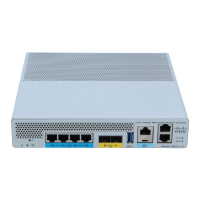CPU console port, which is an RJ-45 RS-232 and
micro-B USB serial console port. The default RJ-45
serial port settings are 9600, N, 8, 1. The boot-loader
supports baud rates of 1200, 2400, 4800, 9600, 19200,
38400, 57600, and 115200. A default baud-rate
recovery mechanism is not available; however, the
bootloader ensures that the stored baud rate setting
matches one of the allowed values before setting the
baud rate. If a nonstandard value is detected, the baud
rate will default to 9600.
Micro-B USB serial connection takes precedence over
RJ-45 when both connections are made.
If the Micro-B USB console port is used,
the CPU console port that supports RJ-45
connector is ignored. That is, only one of
the two ports are ever active.
Note
5
Micro USB Type-B console port that can be used to
perform software updates in addition to the already
available transfer modes, namely HTTP, TFTP, FTP,
and SFTP.
If you connect both the Micro USB Type-B
console port and the CPU console port,
then USB port takes precedence and the
CPU console port is ignored as only one
of the two ports are ever active.
Note
6
Type A 3.0 USB port used to perform software
updates in addition to already available transfer mode,
namely HTTP, TFTP, FTP, and SFTP.
7
2x 10 G/mGig ports. This mGig port supports speeds
of 10G, 5G, 2.5G, and 1G.
In a High Availability environment, it is
not possible to change the configured port
speed.
Note
8
mGig ports. These mGig ports support only 2.5G and
1G speeds.
Gigabit Ethernet ports 1,2, 3, and 4 are RJ-45
connector form-factors. These ports are designed so
that 1500 VAC rms isolation (per the 802.3
specification) is met between chassis ground and any
Ethernet signal.
The ports can be used for infra-switch
connection using multiple an AP-Manager
or data interface.
Note
9, 10, 11, and 12
Cisco Catalyst 9800-L Wireless Controller Hardware Installation Guide
4
Overview of Cisco Catalyst 9800-L Wireless Controller
Cisco Catalyst 9800-L Wireless Controller Front Panel

